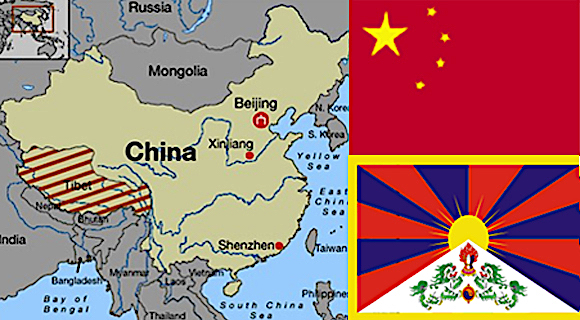Why does the CCP operate military-style mass coercive labor programs in Tibet?
The goal is to fuse Tibetans, Uighurs and other minorities into the majority ‘melting pot,’ like the Manchus before them.
For many months, the Chinese Communist Party (CCP) has been in the news for a number of reasons, from covering up vital information on COVID-19 and supplying millions of damaged masks, to the aggressive wolf-warrior diplomacy spearheaded by Foreign Ministry spokesman Zhao Lijian and China’s ongoing standoff with India in the Galwan Valley.
Despite receiving a number of setbacks because of the CCP’s erratic behaviour, it is still adding to its growing number of both domestic and external woes.
Currently the CCP has been intensifying its war on what it calls its minorities, created and engineered by their past invasions and enforced assimilative policies in these occupied territories.
The latest findings of Adrian Zenz, a Senior Fellow and an independent Tibet and East Turkistan researcher based in Minnesota (USA), confirm that the CCP is now uprooting them from their farms and pasture lands, forcing them into labour programmes and Sinicising them.
Some of these so-called minorities once ruled and moulded China into its present shape and size.
For instance, the Mongols incorporated China into their vast empire.
The Manchu’s extended the Qing Empire’s furthest reach.
Now the Manchus are indistinguishable from the Chinese majority, so totally Sinicised are they now.
And their land, Manchuria, is now renamed Heilongjiang.
At the last count, more than twenty years ago, only 100 elderly Manchu’s were able to speak their mother tongue.
With their death the world has lost an important repository of knowledge and wisdom with its rich linguistic and cultural heritage.

During the ancient period, Tibet overran Xian, the imperial capital of Tang China and installed a puppet emperor on the throne.
The puppet was named Tashi.
In Tibetan it means auspicious.
Emperor Tashi’s reign lasted for fifteen long days. The Tang imperial troops re-grouped and drove the Tibetan army out of Xian.
Now in the twenty first century, after the implementation of ‘Grid-style social management’in the form of ‘Convenience police stations’ and ‘Community based-policing’ why is the CCP undertaking this massive and potentially explosive social engineering of Tibetans and Uighurs of East Turkestan (Ch. Xinjiang) in the form of mass coercive labour programme across Tibet?
The answer that stares one in the face is that Beijing wants these people to go the way of the Manchus, submerged and disappeared in the sea of the Chinese majority.

Because of the CCP’s complete failure of its past policies in Tibet and East Turkistan which resulted into the major peaceful uprising on the Tibetan Plateau in 2008 and the unrest in Urumqi in East Turkistan in 2009, the immediate official response was brutal reprisal, imprisonment and torture.
The majority view of Chinese intellectuals on the party’s minority policy is that it is a major failure and in need of a total overhaul.
Hence, it seems that the CCP has already started recalibrating its minority policy through the mass internment of millions of Uighurs and the implementation of military-style coercive labour programmes in Tibet.
The enduring fear of the Chinese Communist Party is the spectre of the break-up of Yugoslavia and the implosion of the Soviet Union.
To avoid such a fate, rather than expanding autonomy and minority freedom, scholars and officials alike recommended curtailing autonomy and doing away with preferential treatment to minorities who are considered too “pampered” under the current dispensation.
Leading the charge in “correcting” China’s minority policy are Ma Rong of Peking University, Hu Angang, of Tingshua University and Zhu Weiqun, once the executive director of the United Front Work Department, the party’s top office that supervises minority policy.
They recommended minority distinctions should be done away with, and the minorities fused in the “melting pot” of Chineseness.
Some ultra-nationalist Chinese People’s Liberation Army (PLA) generals went further.
They wanted Tibet to be broken into smaller pieces and Beijing should actively encourage more migration of Chinese settlers into these regions to cement and entrench Beijing’s rule, which is presently being done at gunpoint and through an engineered development.
Through the implementation of these different tactics, CCP wants to cement its rule by the sheer weight of Chinese demography and turn Tibet into another Manchuria.
In the words of Adrian Zenz, “…It is likely that these policies will promote a long-term loss of linguistic, cultural and spiritual heritage.”
Hence, by engaging them through this coercive programme, the CCP is trying to disengage the Tibetan people from their roots and culture.
Chunks of what Tibetans consider Tibet, the Water Tower of Asia, are already incorporated into Chinese provinces of Gansu, Sichuan and Yunnan.
Amdo, the birthplace of the Dalai Lama in north-eastern Tibet, was made into a brand-new province and Sinicised as Qinghai.
The Tibet Autonomous Region is a little less than half of the area of 2.5 million square kilometres of the Tibetan Plateau.
If the ongoing dispersal of an estimated 500,000 Tibetans into other Chinese provinces or evicting nomads from their pasturelands or farmers from their farmlands and pushing them into coercive labour programmes is the CCP’s way of fusing minority identities into the greater Chinese melting pot, the CCP might be fueling a boiling pot rather than a melting pot.
In short, what happened in East Turkistan (Ch. Xinjiang), is happening in Tibet and what happened in Tibet, is happening in East Turkistan.
Hence, what happened in East Turkistan and Tibet could happen anywhere.
About the author: Thubten Samphel is the former director of the Tibet Policy Institute in Dharamshala. He is now retired and lives in South India.












Comments are closed.